Most of the anonymous reports threaten schools of various cities across the country. The State Service for Emergency Situations (SSES) has reported on more than 300 sham bomb reports since the year start. Those threatened over 3,000 facilities across Ukraine,
Calling in a fake bomb threat may land a wrongdoer in prison for up to eight years under the Ukrainian legislature.
On 14 January, National Police chief Ihor Klymeneko reported:
"During the New Year holidays alone, we received 132 such reports. Nine perpetrators have been detained in nine regions, including large cities – Kyiv, Dnipro, and Odesa. The culprits had different motives for committing the crime. Some were in a state of intoxication," said Klymenko.
However, as the series of New Year holidays ended on 14 January with the so-called "Old New Year," the number of bomb threats soared.
The "phone terrorists" have been reporting on bombs allegedly planted in various regions of Ukraine at schools, hospitals, government and law enforcement offices, subway stations, airports, and other infrastructure facilities.
In their today's report, the Emergency Service says that early 2022 has become a real ordeal not only for law enforcement agencies who respond immediately to all such threats, but also for students, their parents, and teaching personnel of educational institutions.

"Today we can confidently state that the series of sham bomb threats is nothing but an element of hybrid aggression and a pre-planned information operation. The purpose of this information terrorism is to keep Ukrainians tense and instill insecurity, carrying it out not as a terrorist act, but as a possibility for it to happen. Therefore, the main point is to stay calm," says Ukraine's State Service for Emergency Situations.
Additionally, the agency highlights that the sham bomb reports come from Ukraine's Russian-occupied territories or from Russia proper.
Bomb threats of 24 January in Ukraine
Here are examples of several bomb-threat-related news reports of 24 January in Ukraine. The list is not exhaustive. A similar picture has been in Ukrainian news every day for more than a week.
- A bomb threat email sent to SBU threatened schools and "certain facilities" in Poltava, suspending schooling for the time of the checks. It was the third consecutive day of bomb threats for Poltava schools.
- A bomb threat stopped the educational process in all educational institutions in Chernihiv, including schools and kindergartens, all students and personnel were evacuated.
- In Odesa, an unknown person reported in an email sent to SBU on "mining" all of the city's educational institutions and shopping centers, causing evacuations.
- In Mykolaiv, an anonymous bomb threat led to the evacuation of the city's all educational institutions, the regional council, regional police chief's office, and offices of large commercial companies.
- Students of all schools in Kryvyi Rih were sent home after a bomb threat claiming that explosive devices were planted in educational facilities. The bomb threat came in a letter sent by an anonymous person who introduced himself as a "secret agent of Russia" and threatened that in an hour all schools in Kryvyi Rih would "be blown sky-high."
- A school in Kharkiv was evacuated due to a bomb threat sent by email.
- All educational institutions evacuated in Zaporizhzhia.
- The College of Art and Technology was "mined" in Cherkasy.
- Zhytomyr's kindergartens, shopping malls, the airport evacuated to inspect the facilities after bomb threats.
Law enforcers didn't find any explosive devices after inspections of the facilities.
Since the beginning of Russian aggression in 2014, bomb threats are a regular occurrence in Ukraine. Currently, however, the number of those per day and the scale of them is much higher than usual.
In 2014-2015, at the early active stages of the still ongoing Russo-Ukrainian war, a number of actual terror attacks took place across Ukraine, primarily in Kharkiv and Odesa cities and namesake oblasts, dying down further on. However, actual terror attacks tended to be not preceded by phone threats.
Update: Ukraine's foreign ministry shared the statistics of hoax bomb threats in Ukraine, saying that in January law enforcers received a total of 945 messages which threatened 9,907 facilities across the country:
January stats of the "epidemic" of hoax bomb threats in Ukraine, by @MFA_Ukraine pic.twitter.com/tXcnJgQlWB
— Euromaidan Press (@EuromaidanPress) February 1, 2022
Read more:
- Car bomb in Kherson Oblast kills one and injures four (2016)
- Bomb explodes during Kharkiv march -- 3 killed, 10 wounded (2015)
- Ukraine's Security Service arrests suspects in Kharkiv bombing (2014)
- Russian special services planned terrorist attack in central Kyiv (2014)

